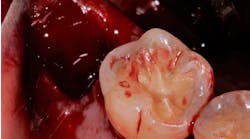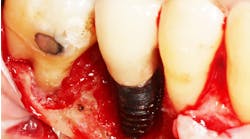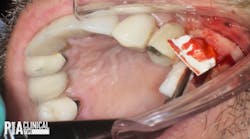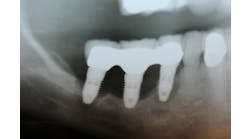The link between periodontal disease and cancer: A review
Introduction
A recent National Health and Nutrition Examination Survey estimated the prevalence, severity, and extent of periodontitis in the adult U.S. population, with data from 2009 and 2010, and found that more than 47% of the sample, representing 64.7 million adults, had periodontitis, distributed as 8.7%, 30.0%, and 8.5% with mild, moderate, and severe periodontitis, respectively. Early symptoms of many systemic diseases manifest themselves in the oral cavity months or even years before their detection through various medical tests. Many systemic conditions such as diabetes, cardiovascular disease, low-birth-weight complications in pregnancy, and pulmonary disease have been linked to periodontal disease. Lately, a link between periodontal disease and cancer has been suggested through several studies. Chronic inflammation has been the rationale behind the association looking both at specific types of cancers and periodontal disease.
Oral cancer — Evaluation of several studies has shown an increased risk of oral cancer with periodontal disease or tooth loss. In fact, Tezal et al. found an increased incidence of oral tumors or precancerous oral lesions in patients with greater than 1.5 mm clinical attachment loss. He found a significant increased risk of oral tumor (OR 4.57) and precancerous lesion (OR 1.55) with >1.5 mm CAL both still significant in never smokers (tumors OR 1.63, precancerous OR 1.32). Furthermore, his study between 1999 and 2005 depicted a significantly increased risk (OR 5.23) of tongue cancer with each mm of bone lost after smoking adjustment. In other studies, tooth loss was identified as an independent risk factor for oral cancer because of the chronic trauma and irritation of the oral mucosa, which may play a role in carcinogenesis. Another study has found a significant 2.7-fold increase in risk of oral cancer for participants who lost 11 or more teeth, compared to those who lost none, after adjustment for alcohol and smoking. Oral cancer risk was even higher in persons who smoked cigarettes, drank alcohol, and had lost teeth without replacement (OR: 12.8, 95% CI: 4.9, 33.8) when compared to individuals who did not smoke or drink and had not lost any teeth.
Upper GI and gastric cancers — The link between periodontal disease and upper GI and gastric cancers has been evaluated in a number of studies. In Japan, a case-control study showed two-fold increased odds of gastric cancer in people with 10 and more teeth loss. There is a significant dose-response relationship observed between the odds of developing gastric cancer and the number of teeth lost. However, other studies, such as Michaud et al., reported no significant association between stomach cancers and history of periodontal disease verified by radiographic bone loss or with tooth loss as well. As of today, there is no evidence supporting a link from gastric or upper GI cancer with periodontal disease.
Pancreatic cancer — Pancreatic cancer is the fourth leading cause of cancer death in the United States. More than 30,000 Americans are expected to die from the disease this year. It is an extremely difficult cancer to treat and little is known about what causes it. One established risk factor in pancreatic cancer is cigarette smoking; other links have been made to obesity, type 2 diabetes, and insulin resistance. In a new study, researchers at the Harvard School of Public Health (HSPH) and Dana-Farber Cancer Institute found that periodontal disease was associated with an increased risk of cancer of the pancreas. Michaud et al. looked at a link between pancreatic cancer and history of periodontal disease and found a significant association between the two — in fact, finding a higher association among the nonsmokers than the smokers. Hujoel et al. also observed an increased risk for pancreatic cancer in individuals with periodontitis in the NHANES I population. In conclusion, the evidence favoring an association specifically with periodontal disease appears promising for pancreatic cancer.
Lung cancer — Several investigators examined the relationship between lung cancer and tooth loss or periodontal disease. Studies from investigators, including Hujoel et al., examined the relationship between periodontal disease by clinical examination and lung cancer and reported no significant results after limiting the effects of never smokers. On the other hand, Michaud et al. found a significant increased risk in patients with periodontal disease that persisted after controlling for smoking. Based on results from these studies, it is not clear whether tooth loss or periodontal disease is associated with lung cancer as most of the excess risk is likely due to confounding by smoking.
Esophageal cancer — A number of studies have found an association between esophageal cancer and missing teeth. A couple of studies showed that the risk of esophageal cancer doubled when missing six to 15 teeth. However, do missing teeth really mean periodontal disease? People loose their teeth for various reasons other periodontitis. Michaud et al. used a specific measure of periodontal disease rather than missing teeth, and their large-scale cohort study failed to find an association with esophageal cancer. It is tricky to ascertain, however, if this translates to a direct link to periodontal disease since only one study showed a significant link with esophageal cancer.
Conclusion and discussion
In light of these findings, there are strong evidence linking periodontal disease or missing teeth with oral cancer, with some studies showing an increased risk with more missing teeth. Pancreatic cancer also showed strong association with periodontal disease. However, in the Michaud et al. 2007 study, the sample was limited to health professional males, which might not be a good generalization. Regarding the risk association with overall cancer, Cabrera et al. and Tu et al. have found no significant association between cancer mortality and increased number of missing teeth, while Hujoel et al. and Michaud et al. have depicted a significantly increased risk overall of cancer for patients with a history of periodontal disease after controlling for smoking.
It is important to point out the possible confounding factors affecting the association between periodontal disease and various cancer risks. Smoking, socioeconomic status, diabetes, age, gender, and ethnicity — along with genetics — constitute the most common potential confounding factors affecting cancer risk. Dietary factors have been also mentioned in some studies, because patients who have lost many teeth may be less able to include these foods in their diets, therefore eliminating their advantageous effects against cancer risk.
It has been suggested that carcinogenic metabolic by-products of periodontal disease might account for the relationship between the two diseases. Nitrosamines have been linked to cancers of the stomach, pancreas, and esophagus. Furthermore, the presence of inflammatory cells and mediators such as chemokines, cytokines, and prostaglandins associated with tumors represent the main indicators.
Author bio
Comlan Missih did his undergraduate study at The State University of New York at Buffalo, obtaining a BS in biochemistry and a BA in mathematics. He went to dental school at Stony Brook University School of Dental Medicine, where he received his DDS degree in 2012 and is expected to earn his MPH in 2014. Dr. Missih is currently enrolled in the postdoctorate periodontology program at Stony Brook University School of Dental Medicine.
References
1. Pihlstrom B, Michalowicz B, Johnson N. Periodontal diseases. Lancet 2005; 366: 1809-1820.
2. Michaud DS, Liu Y, Meyer M, Giovannucci E, Joshipura K. Periodontal disease, tooth loss, and cancer risk in male health professionals: a prospective cohort study. Lancet Oncol 2008; 9: 550-558.
3. Michaud D, Joshipura K, Giovannucci E, Fuchs C. A prospective study of periodontal disease and pancreatic cancer in U.S. male health professionals. J Natl Cancer Inst 2007; 99:171-175.
4. Tonetti M, D’Aiuto F, Nibali L, et al. Treatment of periodontitis and endothelial function. N Engl J Med 2007; 356:911-920.
5. Abir Al Ghuzlan, Bernard Caillou, Martin Schlumberger. Institut Gustave Roussy and University Paris XI-Sud. Lancet 2008; Vol. 9.
6. Ekel PI, Dye BA, Wei L, Thornton-Evans GO, Genco FJ. Prevalence of periodontitis in adults in the United States: 2009 and 2010. J Dent Res 2012; 91:914. Originally published online Aug. 30, 2012.
7. Fitzpatrick SG, Kat J. The association between periodontal disease and cancer: A review of the literature. Journal of Dentistry 2010; 38:83-95.
8. Meyer MS, Kaumudi Joshipura, Giovannucci E, Michaud DS. A review of the relationship between tooth loss, periodontal disease, and cancer. Cancer Causes Control 2008; 19:895-907.
9. Zheng TZ, Boyle P, Hu HF, et al. Dentition, oral hygiene, and risk of oral cancer: a case-control study in Beijing, People’s Republic of China. Cancer Causes Control 1990; 1:235-241.
10. Tezal M, Grossi SG, Genco RJ. Is periodontitis associated with oral neoplasms? Journal of Periodontology 2005; 76:406-410.
11. Marshall JR, Graham S, Haughey BP, et al. Smoking, alcohol, dentition, and diet in the epidemiology of oral cancer. Eur J Cancer B Oral Oncol 1992; 28B:9-15.
12. Michaud DS, Liu Y, Meyer M, Giovannucci E, Joshipura K. Periodontal disease, tooth loss, and cancer risk in male health professionals: a prospective cohort study. The Lancet Oncology 2008; 9:550-558.
13. Guha N, Boffetta P, Filho VW, Neto JE, Shangina O, Zaridze D, et al. Oral health and risk of squamous cell carcinoma of the head and neck and esophagus: results of two multicentric case-control studies. American Journal of Epidemiology 2007; 166:1159-1173.
14. Hujoel PP, Drangsholt M, Spiekerman C, Weiss NS. An exploration of the periodontitis-cancer association. Annals of Epidemiology 2003; 13:312-316.
15. Cabrera C, Hakeberg M, Ahlqwist M, Wedel H, Bjorkelund C, Bengtsson C, et al. Can the relation between tooth loss and chronic disease be explained by socioeconomic status? A 24-year follow-up from the population study of women in Gothenburg, Sweden. European Journal of Epidemiology 2005; 20:229-236.







